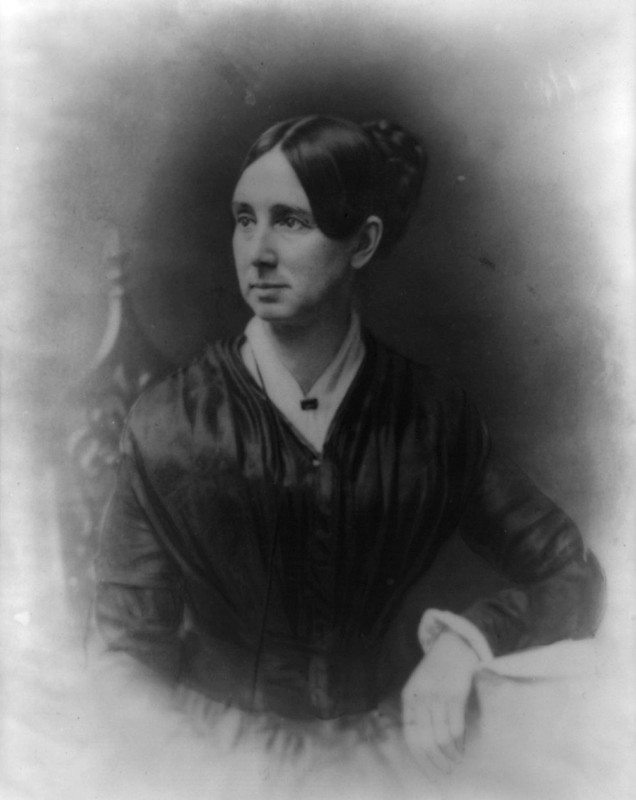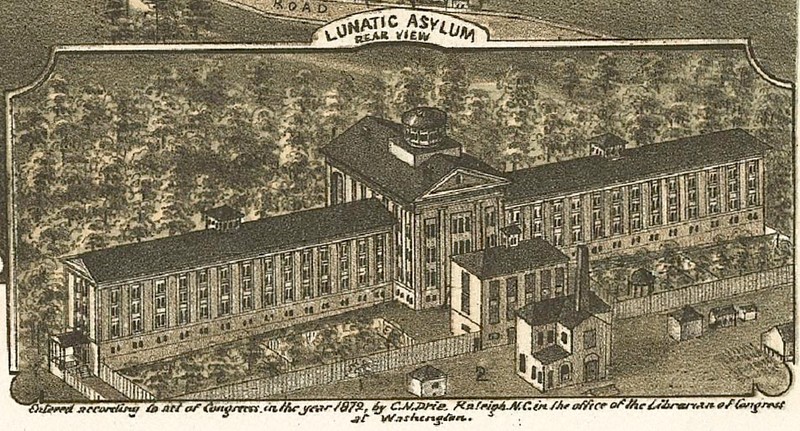Dorothea Dix Hospital Historical Marker
Introduction
Text-to-speech Audio
Images

A photo of Dorothea Dix

The original image of the hospital Dorothea Dix worked to establish in Raleigh, North Carolina

Backstory and Context
Text-to-speech Audio
Dorothea Lynde Dix (1802-1887) was raised in Worcester, Massachusetts as one of three children. After suffering from years of abuse and mistreatment from her parents in her early childhood, Dorothea and her siblings were sent to live with their wealthy grandmother in Boston. At the age of fourteen, Dorothea began to teach at a school in Worcester, Massachusetts, developing her own curriculum for her class and placing strong emphases on ethics and compassion.
Around 1821, Dix opened her own school in Boston, which was bolstered by the support of wealthy families in the area. Additionally, Dorothea began teaching children of low socioeconomic status and neglected households out of the barn of her grandmother's house. From 1824 to 1830, Dix spent a large portion of her time writing devotional and educational books and stories for children. One of these books, called Conversations on Common Things: Or, Guide to Knowledge, with Questions (1824), was reprinted 60 times due to its immense popularity. Another book written by Dix, The Garland of Flora (1829), was one of the first two dictionaries of flowers published in the United States.
It is suspected that Dix herself suffered from major depressive episodes, and poor health brought upon her by these episodes, throughout her life. Around the age of 28, Dorothea was no longer able to run the school she began in Boston because of her poor health brought on by mental illness. However, Dorothea still continued pursuing her passion for teaching, becoming a governess on Beacon Hill for the family of William Ellery Channing, a leading Unitarian intellectual. Dix established another model school for girls in Boston in 1831, which she operated until she suffered another mental breakdown in 1836. After this, Dix was encouraged by physicians to travel to Europe to improve her health.
While in Europe, Dix met a number of pivotal figures which made an extremely lasting impact upon her life's work. Elizabeth Fry, an English prison and social reformer, Samuel Tuke, a philanthropist and mental health reformer, and the philanthropist William Rathbone were major inspirations for Dorothea during her time in Europe. Additionally, Dix visited an institution in Turkey which would later be used as a model for the institutions she created. She met a number of other reformers who believed that government should have a prominent role in social welfare, and was introduced to the reform movement for care of the mentally ill that was taking place in Great Britain at the time.
When Dix returned to America around 1840, she was determined to apply the knowledge she had gained in Great Britain to the appalling institutional practices that were taking place in the U.S. Upon her return, Dorothea began teaching classes to female prisoners at a prison in East Cambridge, Massachusetts. Here, she was horrified by the destitute state of the prison; many prisoners, particularly those with mental illness, were living in subpar living conditions with no heat, as well as being confined with violent prisoners instead of being given the attention and treatment they deserved. After her experience at the prison, Dix conducted a statewide investigation of the care being given to the poor mentally ill people in Massachusetts.
Dix's investigation brought disheartening results, to say the least. In most towns in Massachusetts, care for the mentally ill was extremely unregulated and unfunded, which meant that many mentally ill persons were subject to various forms of abuse. Dix eventually published her results in a report to the Massachusetts state legislature, stating that, "I proceed, Gentlemen, briefly to call your attention to the present state of Insane Persons confined within this Commonwealth, in cages, stalls, pens! Chained, naked, beaten with rods, and lashed into obedience." For years afterward, Dorothea continued to lobby for better treatment of the mentally ill. She appealed to the legislatures across the United States, from New Hampshire to Louisiana, showing terrible prison and asylum conditions and pushing for reform. In 1847, her relentless push for better conditions for the mentally ill impelled Illinois to establish its first state mental hospital.
In 1848, Dix visited North Carolina, where she continued to push for reform in care of mentally ill patients. Initially, Dix's appeal to North Carolina's state legislature was denied; however, after a board member's wife requested that Dix's plea be considered as her dying wish, Dix's bill for reform was improved. In 1849, the legislature authorized the construction of an institution for mentally ill patients in Raleigh, North Carolina. This institution, initially named the Dix Hill Asylum after Dorothea's father, opened in 1856. In 1956, the institution was renamed the Dorothea Dix Hospital in honor of all she accomplished for mentally ill patients and healthcare reform. Due to Dix's efforts, state hospitals for the mentally ill were authorized in Morganton, NC (Broughton State Hospital) as well as the eastern part of the state (Goldsboro Hospital for the Negro Insane). She was also instrumental in the foundation of the first public mental hospital in Pennsylvania, the Harrisburg State Hospital.
While Dix's efforts for reform of care for the mentally ill had already made monumental changes by this point, the most lasting impact of Dix's work took place in 1854, when she proposed the Bill for the Benefit of the Indigent Insane to the United States legislature. Dix's proposed legislation asked that 12,225,000 acres of Federal land be used for the benefit of the mentally ill as well as those who were handicapped. The bill also proposed that the proceeds gained from this land would be distributed to asylums throughout the U.S. Dix's bill was approved by both houses of the United States Congress, but was vetoed by President Franklin Pierce, who thought that social welfare was the responsibility of the states.
After meeting this discouraging response, Dix again traveled to England and Europe in hopes of finding further inspiration. She continued to push for reform, researching Scotland's "madhouses" and eventually playing a major role in care reform in Scotland. Her work also led to major reform in Italy and Nova Scotia. Upon her return to America, Dix was appointed Superintendent of Army Nurses by the Union Army in the American Civil War. Following the end of the War, Dix again devoted herself to her work on reforming care conditions for the mentally ill, prisoners, and the disabled, which she continued until her death in 1887. Today, Dorothea Dix is considered one of the most influential women and one of the most important figures of social welfare reform in United States history. Her legacy is now commemorated with a number of historical markers, statues, and plaques; one of these stands at the intersection of Western Boulevard and South Boylan Avenue in Raleigh, N.C., at the location of the former Dorothea Dix Hospital.
Sources
Wikipedia Contributors. "Dorothea Dix." Wikipedia, 1 May 2020, https://en.wikipedia.org/wiki/Dorothea_Dix. Accessed 20 May 2020.
Goldsmith, Thomas. "Dorothea Dix Hospital - Interactive History Timeline." 11 Oct., 2016, https://www.northcarolinahealthnews.org/2016/10/11/dorothea-dix-hospital-interactive-history-timeline/. Accessed 22 May 2020.
https://www.hmdb.org/m.asp?m=94631
https://en.wikipedia.org/wiki/Dorothea_Dix
https://www.northcarolinahealthnews.org/2016/10/11/dorothea-dix-hospital-interactive-history-timeline/
